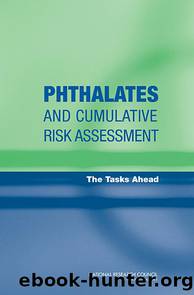PHTHALATES AND CUMULATIVE RISK ASSESSMENT: The Tasks Ahead by National Research Council of the National Academies

Author:National Research Council of the National Academies
Language: eng
Format: epub
Tags: Math, Chemistry and Physics : Chemistry. Environment and Environmental Studies : Pollutants and Toxics. Policy for Science and Technology. Health and Medicine : Public Health and Prevention
Publisher: NATIONAL ACADEMY PRESS
Published: 2008-12-19T00:00:00+00:00
The statement defining dose addition says nothing about the shapes of the dose-response curves for the individual components, and nothing can be adduced about the dose additivity or non-dose additivity of a mixture from the shapes of the dose-response curves of its components (undocumented statements to the contrary in EPA 2000, Section 4.2.2 and Table B-1, notwithstanding). Several observations about the definition of dose addition are of particular interest.
⢠First, the dose additivity of a particular mixture does not imply the dose additivity of other mixtures of the same components. Mixtures of the same components may be non-dose additive for different component dosesâindeed, may be synergistic (producing an effect larger than expected for dose addition, with the sum of the left side of Equation 1 smaller than unity) at some combinations of component doses, and antagonistic (producing an effect smaller than expected for dose addition, with the sum of the left side of Equation 1 larger than unity) at others. Figure 4-1 provides a striking example of such a situation for a two-component mixture.
⢠Second, conclusions about dose addition, synergism, or antagonism or more generally about the shape of an isobole may not be the same for different levels of effect even for similar mixture ratiosâgeometrically, isoboles are not necessarily parallel.
⢠Third, the doses DA, DB, DC., ⦠vary with the effect level; indeed, theyare just the inverses of the individual dose-response curves of the components. Box 4-2 shows how to derive the dose-additive multiple-dose-response curve for the mixture from the individual dose-response curves of the components.
⢠Fourth, with the definition of dose addition stipulated by Equation 1, the evaluation of dose-additivity or nonadditivity is a matter entirely for observation using measured dose-response curves; no consideration of mechanism of action is required.
⢠Fifth, it is not necessary to determine any dose-response curve fully to evaluate additivity or nonadditivity of a mixture at a specific level of effect E. What is required are the doses of the individual components that, acting alone, would give a response level E and the component doses of the mixture that would give a response level E. Then if Equation 1 holds, that mixture is dose-additive at response level E.
Download
This site does not store any files on its server. We only index and link to content provided by other sites. Please contact the content providers to delete copyright contents if any and email us, we'll remove relevant links or contents immediately.
Whiskies Galore by Ian Buxton(41883)
Introduction to Aircraft Design (Cambridge Aerospace Series) by John P. Fielding(33064)
Rewire Your Anxious Brain by Catherine M. Pittman(18554)
Craft Beer for the Homebrewer by Michael Agnew(18145)
Cat's cradle by Kurt Vonnegut(15189)
Sapiens: A Brief History of Humankind by Yuval Noah Harari(14254)
Leonardo da Vinci by Walter Isaacson(13189)
The Tidewater Tales by John Barth(12609)
Thinking, Fast and Slow by Kahneman Daniel(12080)
Underground: A Human History of the Worlds Beneath Our Feet by Will Hunt(12026)
The Radium Girls by Kate Moore(11926)
The Art of Thinking Clearly by Rolf Dobelli(10229)
A Journey Through Charms and Defence Against the Dark Arts (Harry Potter: A Journey Throughâ¦) by Pottermore Publishing(9233)
Mindhunter: Inside the FBI's Elite Serial Crime Unit by John E. Douglas & Mark Olshaker(9206)
Tools of Titans by Timothy Ferriss(8222)
Wonder by R. J. Palacio(8012)
Turbulence by E. J. Noyes(7940)
Change Your Questions, Change Your Life by Marilee Adams(7637)
Nudge - Improving Decisions about Health, Wealth, and Happiness by Thaler Sunstein(7622)
